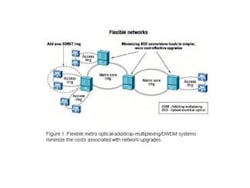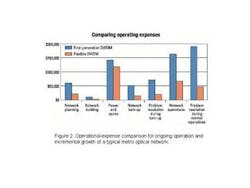Taking it to the streets--flexible metro optical networks
Carriers can meet the needs of MANs today and tomorrow by building flexible metro-optimized DWDM networks.
By ED DZIADZIO
Tropic Networks
The promise of metro DWDM solutions has been discussed for some time. However, large-scale deployment of these solutions has been held back by the relative inflexibility and associated costs of these systems.
Metro DWDM networks are very fluid in nature--traffic patterns are changeable and diverse. A single metro location will often share traffic with multiple locations within the same metro area. For example, a corporate site may share traffic with other corporate sites or a data center as well as connect with an Internet service provider and/or long-haul provider.
MANs must accommodate reconfigurations and upgrades. New customers are added to the network, leave the network, change locations, and change their bandwidth requirements and service types. Additionally, new services may be introduced by the carrier and must be supported by the network. To support changing traffic patterns and bandwidth and service requirements, optical MANs must be highly flexible. That leads to some fundamental requirements for DWDM and optical-add/drop-multiplexing (OADM) equipment destined for metro networks.
MANs are particularly cost-sensitive, needing to maximize the useful life and long-term capabilities of deployed equipment while minimizing up-front investment. However, this long-term cost-effectiveness must be balanced with the required day-to-day and week-to-week flexibility of the DWDM/OADM solution.
What flexibility means
Let's define "flexibility" a bit more precisely as it relates to the requirements of the optical MAN. The key requirements to cost effectively support the changes that continuously take place in metro optical networks can be grouped into four categories:
Visibility--The carrier needs the ability to see what is happening in the network to confidently and efficiently plan and implement network changes. That includes visibility into the optical layer as well as electrical layer. At the optical layer, it is necessary to understand network topology and span losses before reconfiguration begins. Specifically, information is required for each and every wavelength in the network on a wavelength-by-wavelength basis and in real time.
Scalability--Scalability enables the addition of wavelengths and nodes to support new services or expansion of existing services. Also, it is necessary to support adding more bandwidth and new services to existing wavelengths. The additional services may already exist or could be newly introduced by a carrier to its customers and the metro network. Scalability also requires supporting the addition of fiber, whether to connect to new network locations or enhance existing fiber spans in cases where the existing fiber has reached its maximum capacity.
Upgradability--The network must scale in a cost-effective nondisruptive manner. These criteria are rarely met in today's networks due to the high operating costs associated with network changes. Current metro DWDM implementations require many truck rolls and a heavy involvement by field personnel when changes are made to the optical network--and changes can often be disruptive to existing network traffic.
Optical agility--Dealing with optical signals as optical signals minimizes extraneous equipment and optical-electrical-optical (OEO) conversions. That applies to OADM and DWDM equipment. Optical agility includes the ability of the DWDM gear to accept, transport, and manage wavelengths from SONET ADMs and other equipment. It also includes optically bypassing nodes and moving optical signals from one ring to another without OEO conversion. Maximizing wavelength reuse also falls into this category. Optical agility has a very real impact on capital and operating expenditures (capex and opex).
Figure 1 highlights the key points in the MAN where upgradability and optical agility are introduced with flexible DWDM/OADM systems. These four requirements taken together provide the basis for a truly flexible optical MAN--and a network capable of meeting the demands of a carrier and its customers cost-effectively.
Key capabilities
To meet the requirements for a flexible optical MAN, solutions must be designed with that in mind. Attempts at adopting long-haul DWDM equipment for the metro market--so-called first-generation metro DWDM solutions--have not been successful when judged against the above criteria.
The equipment that carriers install today must gracefully scale to meet the demands of the future. "Gracefully scale" means scaling and changing without service disruption and at minimum capex and opex.
So in addition to the well-known basics of a DWDM/OADM solution, what else is required to impart the necessary flexibility to optical MANs? Advanced, integrated optical layer management is required to understand what is happening in the network in real time. By integrating advanced optical layer management capabilities into the metro DWDM solution, the information gathered from the network is automatically fed to the relevant management system, correlated with other network information as required, and is available for immediate use at the network operations center.
A real time understanding of each wavelength path through the network is crucial to visibility and optical agility. Per-wavelength identification and path trace capabilities uniquely identify each wavelength in the network and depict how they traverse the network. This type of visibility saves a great deal of time in cases where "mis-fiberings" or other problems arise in network installations, changes, and upgrades. It also enhances wavelength reuse by clearly distinguishing each wavelength--even those of the same color.
Part of optical layer management is optical power management, which includes power monitoring and remote power adjustment. Remote power adjustment is essential to minimize opex (truck rolls and field personnel time) and speed time to new service. With first-generation metro DWDM solutions, truck rolls are required to perform manual adjustments to optical power levels by adding or tuning attenuators. Since wavelengths are the lingua franca of a DWDM/OADM network, power monitoring and adjustment must be enabled on a per-wavelength basis.
The combination of per-wavelength power monitoring and path trace provides the necessary visibility to ensure fast and accurate changes to the network. Per-wavelength remote optical power adjustment contributes directly to network upgradability by simplifying and speeding any power adjustments that may be necessary to effect changes to the optical network.
Network design and planning cannot be overlooked as key elements in enabling a flexible optical MAN. Component placement is a critical aspect of network planning. Third-generation metro DWDM systems allow network designers a great deal of leeway in the placement of amplifiers, filters, and other optical components. That enables network designers to consider future network growth and change possibilities and design networks that meet changes with minimal impact to current operations.
Wavelength planning is another aspect of overall network planning, which contributes greatly to the network's ability to easily accommodate future changes while minimizing current and future costs. Intelligent wavelength planning, buttressed by real time wavelength-level visibility into the network, maximizes wavelength reuse, thereby leaving the maximum possible "headroom" for growth. Wavelength reuse also minimizes current costs by limiting the amount of spares a carrier must keep on hand.
These capabilities provide the underpinnings necessary for DWDM equipment to support a flexible optical MAN. But how do these capabilities translate into real savings in real networks?
Operational business case
In deploying any optical MAN, a carrier must consider immediate capex and ongoing opex. While capital expenses are relatively easy to quantify and compare across vendors, operational expenses are much more difficult and have therefore received less attention. However, operating expenses are a much larger part of running a network, so they must be examined closely.
A great deal of research has been done with carriers and industry consultants to understand the impact of a truly flexible metro optical implementation on total network costs. A total cost of ownership model, including capex and opex, has been developed to dissect and understand these costs. The model includes a number of variables that can be adjusted to meet the situation of a particular carrier. The focus here will be on a real-life network.
The network model includes scenarios for an initial network build and the incremental growth of that network. Within both scenarios, the key activities modeled are network planning, network building (including adding new wavelengths), power and space, network turn-up, and network operations. The network turn-up and network operations activities have options for modeling turn-up problems and ongoing operations issues.
All of these modeled activities contain variables that can be adjusted according to a carrier's experience and current situation. Variables include but are not limited to levels of problem severity, labor rates, time to perform tasks such as installation and maintenance, space and electrical power costs, transportation rates, and personnel training costs.
In our example case, a carrier is running multiple SONET rings over DWDM architecture. The current DWDM implementation consists of a first-generation point-to-point solution. The traffic modeled is hubbed and fully protected at the DWDM layer. Sixteen wavelengths were initially provisioned. Traffic on the network continues to grow and more SONET capacity is added, including the need for additional wavelengths.
Figure 2 provides an example of the opex savings achieved when optical MANs are designed with flexibility in mind. This example depicts the costs associated with annual ongoing operations, plus incremental growth of one wavelength in a metro DWDM network. Operational savings across all categories in the graph total 58% for the flexible DWDM approach compared to typical first-generation approaches.
The savings depicted derive directly from the capabilities that have been highlighted earlier. For instance, when upgrading the network, being able to immediately pinpoint the source of a crossed fiber or other problem instead of spending hours or days in the field with optical test gear delivers the savings shown in Figure 2 for the area labeled "problem resolution during turn-up."
Covered here are the opex associated with the operation and growth of the network after initial installation--the area of greatest savings for flexible optical MAN implementations. However, smaller savings are also realized in the initial network deployment. Additionally, larger savings (in this case, 64%) are realized for the capex associated with incrementally growing the network. These types of savings in opex and capex associated with incremental growth are directly attributable to the capabilities included in metro DWDM systems that enable flexible optical MANs.
Flexible approaches win
Carriers need to invest in metro DWDM to accommodate traffic growth and customer demands (storage services, Gigabit Ethernet services, high-bandwidth SONET, and wavelength services). But before they make large investments, carriers must be assured that their capital expenses are invested in solutions flexible enough to grow and change with their customer base. Carriers must have a keen understanding of how equipment capabilities impact opex.
By building flexible, metro-optimized DWDM networks, carriers can serve the needs of MANs today and in the future and at the same time minimize the expenses associated with implementing and operating these networks. To make flexible DWDM networks a reality, metro carriers must pay keen attention to optical layer management capabilities, power strategies, and network and link planning expertise. These capabilities deliver the scalability, visibility, and upgradability required to cost-effectively change and grow metro DWDM networks over time.
Ed Dziadzio is director of product marketing at Tropic Networks, headquartered in Ottawa, Ontario.

